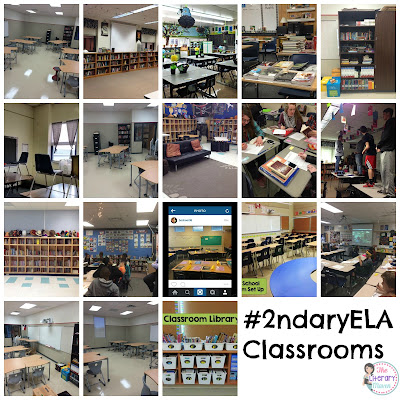This week's #2ndaryELA Twitter chat was all about the books. We chatted about our students' favorite reads, building, organizing & managing our classroom libraries, and matching students' interests. The highlights are below.
Recommended Genres: science fiction, fantasy, dystopyia, pop fiction, graphic novels, sports related, mysteries
Recommended Authors: Sharon Draper, Michael Vey, Mike Lupica, John Green Green, James Patterson, James Swanson
Recommended Titles: Thirteen Reasons Why, Speak, Divergent series, If I Stay, A Fault in Our Stars, Into the Wild, The Hunger Games series, Fish in a Tree, One For the Murphys, The Giver, Touching Spirit Bear, Drums Girls & Dangerous Pie, The Pearl, The Outsiders, And Then There Were None, The Great Gatsby, Fahrenheit 451, Wonder, Legend. The Maze Runner, The Hobbit, The Land of Stories series, The Westing Game, Duck Dynasty books, Rain Rein, Secret Hum of a Daisy, Counting by 7s, Stella by Starlight, Absolutely Almost, Michael Vey, HIVE series, Eragon series, The Stranger, Unwind series, Challenger Deep, Life as We Knew it, Shatter Me series.

Get books on the cheap from: garage sales, used stores, thrift stores, discount tables at book stores, ask friends and family, Scholastic warehouse sales, First Book for Title 1 schools, Half Price Books, Amazon, Scholastic Book Club, garage sales, student donations, Donors Choose, Ebay, Alibris.
And check out the Booksource app for managing check-in/check-out of books from your classroom library.
Hope you'll join us next week, Tuesday August 4th at 8pm EST to discuss the ELA classroom organization. The questions for next week's chat will be posted here on Sunday. If you missed Tuesday night's chat, scroll down and read the whole thing below.
Recommended Genres: science fiction, fantasy, dystopyia, pop fiction, graphic novels, sports related, mysteries
Recommended Authors: Sharon Draper, Michael Vey, Mike Lupica, John Green Green, James Patterson, James Swanson
Recommended Titles: Thirteen Reasons Why, Speak, Divergent series, If I Stay, A Fault in Our Stars, Into the Wild, The Hunger Games series, Fish in a Tree, One For the Murphys, The Giver, Touching Spirit Bear, Drums Girls & Dangerous Pie, The Pearl, The Outsiders, And Then There Were None, The Great Gatsby, Fahrenheit 451, Wonder, Legend. The Maze Runner, The Hobbit, The Land of Stories series, The Westing Game, Duck Dynasty books, Rain Rein, Secret Hum of a Daisy, Counting by 7s, Stella by Starlight, Absolutely Almost, Michael Vey, HIVE series, Eragon series, The Stranger, Unwind series, Challenger Deep, Life as We Knew it, Shatter Me series.

Get books on the cheap from: garage sales, used stores, thrift stores, discount tables at book stores, ask friends and family, Scholastic warehouse sales, First Book for Title 1 schools, Half Price Books, Amazon, Scholastic Book Club, garage sales, student donations, Donors Choose, Ebay, Alibris.
And check out the Booksource app for managing check-in/check-out of books from your classroom library.
Hope you'll join us next week, Tuesday August 4th at 8pm EST to discuss the ELA classroom organization. The questions for next week's chat will be posted here on Sunday. If you missed Tuesday night's chat, scroll down and read the whole thing below.

















 Brynn Allison,
Brynn Allison, 
